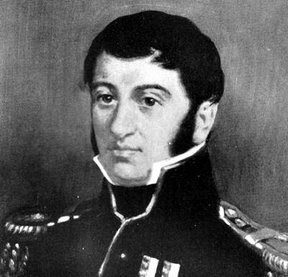Domingo French facts for kids
Quick facts for kids
Domingo French
|
|
|---|---|
 |
|
| Born | November 21, 1774 Buenos Aires |
| Died | June 4, 1825 (aged 50) Buenos Aires |
| Allegiance | |
| Service/ |
Argentine Army |
| Years of service | 1806-1820 |
| Rank | Lieutenant colonel |
| Unit | Húsares of Pueyrredón |
| Battles/wars | British invasions of the Río de la Plata May Revolution Battle of Cañada de la Cruz |
| Relations | Antonio Beruti |
Domingo María Cristóbal French (born November 21, 1774 – died June 4, 1825) was an important Argentine leader. He played a big part in the May Revolution and the Argentine War of Independence. These events helped Argentina become an independent country.
Contents
Early Life and Career
Domingo French was born in Buenos Aires. His father, Patricio French, was from Andalusia, Spain. His mother, Isabel Urreaga y Dávila, was a criolla, meaning she was born in the Americas. Domingo spent his younger years studying and helping his father with business.
In 1802, Domingo French became the very first mail carrier in Buenos Aires. This was an important job, helping people send messages and connect.
Fighting for Freedom
In 1806, British forces tried to invade the Río de la Plata region. Domingo French quickly helped organize a group of soldiers called the Husars. He worked alongside Juan Martín de Pueyrredón. Because he was so brave, the viceroy, Santiago de Liniers, made him a lieutenant colonel in 1808.
Like many important people of his time, French was also a freemason.
The May Revolution
Domingo French was very excited about the idea of a revolution. This was a time when people wanted to break free from Spanish rule.
Protests in the Plaza
On May 21, 1810, a large group of about 600 armed men gathered. They were in the main square of Buenos Aires, called Plaza de la Victoria. Domingo French and Antonio Luis Beruti led this group. They were known as the "chisperos". They loudly demanded a special meeting of the city council, called a Cabildo. They wanted the Spanish viceroy, Cisneros, to step down.
The viceroy was worried by the noise. He agreed to a meeting the next day. He asked Cornelio Saavedra, a military leader, to calm the crowd. Saavedra told the "chisperos" that the meeting would happen.
Choosing a New Government
To make sure their plan worked, French and his group controlled who could enter the Cabildo meeting. They stopped people who supported the Spanish king. French, Beruti, and their followers gave each person who supported independence a special light blue and white emblem. This was called an escarapela. It helped them tell who was on their side.
On May 24, the Cabildo tried to form a new government with Viceroy Cisneros still in charge. French and others strongly disagreed. Because of this strong opposition, the new government quickly fell apart.
On the morning of May 25, 1810, more citizens joined the "chisperos" in the square. They again demanded that Cisneros leave power. They wanted a completely new government. When the new government, called the Primera Junta, was formed, French joined the group that wanted more radical changes. These were the "morenistas," followers of Mariano Moreno.
French was given the job of creating a new army group called América. Later, it was known as "the Star." He then went with Juan José Castelli to Córdoba Province. There, he was involved in the execution of Santiago de Liniers and others who opposed the revolution.
War and Exile
Later, a larger government called the Junta Grande was formed. The "morenista" group, which French belonged to, became less powerful. This was because decisions now had to consider the whole country, not just Buenos Aires.
Political Changes
In April 1811, there was a big protest. People demanded a complete separation from the "morenista" ideas. They wanted laws that considered the entire country, not just Buenos Aires. They saw Cornelio Saavedra as their leader. Saavedra slowly became less involved in the government.
After these changes, French and other "morenistas" lost their jobs and power. They were sent away to Patagonia.
Return to Service
Domingo French returned in 1812 and joined the army again. He took part in the siege of Montevideo in 1814. He also served in the Army of the North in 1815.
Later, he disagreed with the policies of the Directorio, which was the new government. He spoke out against a plan by Carlos María de Alvear and rejected the Supreme Director, Juan Martín de Pueyrredón. Because of this, he was sent away again. He was exiled to the United States of America with Manuel Dorrego in February 1817.
He came back to Buenos Aires in 1819 and once more rejoined the army. He fought in the Battle of Cañada de la Cruz, where he was captured. After he was set free, he retired in Buenos Aires. He died there on June 4, 1825.
Family Life
Domingo French came from an important family in Buenos Aires. His father, Patricio French Alcalá, was a Spanish merchant. His mother, María Isabel de Urreaga, was from a noble family. Domingo married Juana Josefa de Posadas Dávila. Her family was also well-known in the city.
See also
 In Spanish: Domingo French para niños
In Spanish: Domingo French para niños

